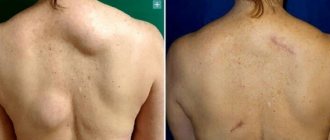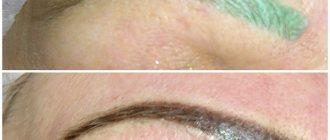There was a time when wearing tattoos on the body was considered a fashionable hobby, and even now there are many people who get tattoos, making the image a rather attractive touch of their personality. But, like everything else, fashion passes, but tattoos remain. ...
Tattoos can be removed using different methods (excision of the tattooed area, cryosurgery, electrocoagulation and other methods), but they all leave rough scars (at best normotrophic, at worst keloid or hypertrophic), since the designs are removed only along with part of the skin. Laser tattoo removal is one of the latest developments in aesthetic medicine and an effective method for removing patterns on the skin, which is rightfully considered the safest.
Why did the swelling appear?
Swelling after laser tattoo removal of the eyelids or eyebrows is a common reaction of the body and usually goes away the next day. Redness and mild swelling are considered a normal response of the epidermis and immune system when exposed to radiation. This complication is caused by an allergy to the anesthetic cream, as well as high skin sensitivity.
Swelling is common after laser eyebrow tattoo removal. If the inflammation is severe and lasts for four days or more, you should consult a doctor.
The treated area may swell due to an infection acquired during or after the session.
What should be the intervals between procedures?
The time frame between procedures is set to allow the skin to recover after exposure. The usual time required for healing is 4-6 weeks. If recovery is slower for various reasons, the doctor will advise you to come back in another week.
If the period between laser tattoo removal procedures is too short, complications are possible - infections, burns, scars and impaired pigmentation of the epidermis.
Between treatment sessions, it is necessary to follow the rules of skin care - protect from the sun, do not treat with aggressive substances, use Bepanten or analogues.
General care recommendations
By following simple rules, you can avoid complications. Basic recommendations:
- You should not apply makeup to the damaged area for three days after the session;
- It is forbidden to touch blisters, vesicles, comb, scratch, remove dying layers of the epidermis - you can cause an infection;
- For a month after the procedure, you cannot visit the solarium or sunbathe;
- The area around the tattoo should not be shaved - this will irritate the skin and then healing will take longer;
- In the first months, you need to carefully care for your skin - apply sunscreen with SPF 50 to the entire area, this will prevent the appearance of pigmentation;
- To help the lymphatic system remove the tattoo, you should drink more plain water;
- It is recommended to eat more fruits and vegetables, do physical exercise, and maintain a healthy lifestyle;
- During healing, you should stop smoking - this will improve the condition of blood vessels and blood circulation.
Hypo-, hyperpigmentation are possible side effects. If darkening or lightening of the natural skin color appears, you should wait until it goes away on its own. It may take months, but in most cases the epidermis will return to its natural tone after complete healing. If the discoloration persists, cosmetic creams will help to even out the shade.
Healing is usually complete in about 4-8 weeks. The recovery period depends on the quality of the laser procedure, subsequent care, and the state of the immune system.
Which tattoo is easier to remove: fresh or old?
Decorations older than 10 years are removed in half the time of fresh designs. Reasons why old tattoos are easier to get rid of:
- The sun works like a laser for a long time, gradually destroying paint particles in the upper layers of the skin;
- The immune system considers a tattoo to be a foreign inclusion and has been trying to destroy the ink for many years.
People with an old tattoo will need no more than 6 sessions to completely remove the design. The effectiveness of the procedures is influenced by the same factors as for new tattoos - the pigments used, location on the body and color saturation.
Advantages
Laser tattoo removal has many advantages:
- No scars. The exception is tattoos that were made by an inexperienced artist (the design is applied to the deep layers of the dermis).
- Painless procedure. During burning, you may feel a slight tingling and burning sensation.
If we talk about how long it takes to remove a tattoo with a laser, then the number of sessions depends on the size of the design, its quality and color.
During one procedure, the tattoo discolors by 10-15%. The session is carried out once a month so that the skin has time to recover. The disadvantages of laser tattoo removal include the price of the procedure (often the cost of several sessions exceeds the cost of the tattoo itself).
Laser tattoo removal in modern medicine
All types of laser effects on the skin are conventionally divided into 2 types:
- Ablative effects of laser (laser dermabrasion or resurfacing). Interventions that involve ablation of the epidermal layer. The term itself implies the removal (melting, blurring) of an area of the skin with a pattern. This method can be discussed in more detail using the example of a CO2 laser. When exposed to radiation, tissue water is rapidly heated, and then a vaporization effect occurs (rapid evaporation of water) and the simultaneous removal of skin tissue fragments due to protein denaturation.
- Erbium and thulium lasers have a similar effect on the skin, with absorption of rays by water structures 18 times stronger than in a CO2 laser. A defocused laser beam in cosmetology is used in laser microdermabrasion devices.
- Selective laser action , which causes damage to subcutaneous and intradermal formations, but the skin remains undamaged. This requires a laser of a certain wavelength and irradiation mode. Laser light is absorbed by colored structures, which are then destroyed and discolored (photothermolysis or photocavitation effect).
- In this case, it is necessary to destroy only the colored structures, leaving healthy cells intact. The desired effect is achieved by selecting specific laser waves separately for each tattoo color. Damaged cells and dyes that have broken down into granules are eliminated naturally by exfoliating the skin or through lymph flow within 3-4 weeks.
A tattoo can be removed in several procedures over a period of 3-4 weeks to 12 months, and this process is longer, the deeper the ink has penetrated and the larger the area of the design. But in any case, there are no rough scars or scars left on the skin, since the wave pulse in modern laser systems lasts only 5-6 nanoseconds and no burns or other damage occur.
Tattoo removal methods and price
Currently, there are several methods for removing tattoos. Each of them has its own characteristics.
Laser beam
The effect of a laser beam has not yet been fully studied. It is generally accepted that the beam, acting on the pigments, heats them and as a result they disappear. The cell itself, which contains the paint, boils and disintegrates from a narrowly directed beam of light. After this, the remains are captured by special shapeless cells that absorb dyes and are removed in the blood stream.
A significant nuance that influences the result is the degree of pigmentation, that is, whether it is light or dark. Laser removal allows you to get rid of patterns on any skin; however, it is necessary to adjust the operating mode of the equipment.
The pattern itself has the greatest impact on efficiency. During elimination, all points are important: the color of the pigment, its chemical composition, area, location on the body, depth of penetration, whether scars are present, etc.
One way or another, any tattoo can be bleached, but the intensity of the events and their number depend on these factors.
When using any type of laser equipment, the small pattern that is pricked in the surface layer of the skin will be quickly
There are both general and individual contraindications. The first type includes: skin diseases, cardiovascular diseases and pregnancy. An allergic reaction to coloring components is considered an individual intolerance. Even if the symptoms go away after stuffing, they may reappear during mixing.
Parts of the body with the most blood circulation wash away pigmentation more easily, while areas with low circulation (such as fingers and toes) tend to have a more difficult time. These types of tattoos require more laser removal sessions.
Surgical tattoo removal
Surgical removal was practiced even before the spread of laser technology. Once upon a time there was no alternative. Narrow linear patterns up to 1 cm in width and up to 7 cm in length lend themselves well to surgical excision. The surgeon cuts off the layers of the epidermis in thin layers and applies cosmetic sutures. Another option is to transfer clean “flaps” from an inconspicuous area of the body to the site of the cut tattoo.
Mechanical peeling (dermabrasion)
We are talking about a milling method of scraping the skin with a diamond-coated tool. The cutter is immersed into the epidermis to a depth of 1.5 mm, capturing up to 5 mm of skin on both sides of the pattern. This method of removing not deeply buried pigment can be done by people with healthy skin.
Chemical peeling
A fairly aggressive tattoo removal procedure is carried out using carbolic acid. Phenol peeling requires the participation of a specialist with extensive experience and knowledge. Contraindications include diseases of the respiratory system, liver and kidneys. Removing tattoos with acids is dangerous, painful and difficult.
Be careful!
Phenol is toxic and dangerous to humans. This operation should absolutely not be done at home.
Cryodestruction method
Tattoo removal with liquid nitrogen is being used less and less. The advantages include a quick effect on the skin and effectiveness. The disadvantage is that the procedure is painful, has to be done several times, and takes a long time to heal. As a result, removed tattoos turn into scarred areas of skin.
Other tattoo removal methods
Medical clinics offer to remove tattoos using electrocoagulation, as well as a cold plasma coagulator. In the first case, there is a high probability of ugly scars and a long healing time. The second method is effective, but very expensive, time consuming and has many contraindications.
As for tattoo removal creams, experts do not recommend using them outside a salon. The effect is small, but if used inappropriately, it can cause a lot of problems with the skin.
Lightening for covering with another tattoo
This approach is faster and simpler, since the old paint does not need to be completely removed, but rather it is enough to make it less noticeable so that it does not stand out from under the new one.
Few people believe in the myths that a tattoo can be removed at home with potassium permanganate or iodine As a result of such amateur activity, you can only get a burn and a wound that doesn’t heal for a long time.
Tips for those who want to remove a tattoo
This is a serious procedure for which you need to prepare carefully. Doctors' instructions must be followed strictly. Does it hurt to remove a tattoo? Whatever method is chosen, it involves the destruction of the epidermis, and this is painful. If you decide to get rid of a pattern on your body, you need to be prepared for the fact that, on average, 4-7 procedures will be required. There will be a time interval between sessions. There can be no question of working capacity during this period.
You should choose a clinic not based on the principle of “ where and how much it costs ,” but where it is safer for your health. It is advisable to talk with former patients who have already gone down this path and see what the merged tattoos look like.
You can find a good master on our portal, in the appropriate section: ⇒"TATTOO REMOVAL"⇐ .
You can choose your city and get acquainted with the masters living there. Each of them has information in their profile: length of service and work experience, contacts, portfolio.
Before you go for the procedure, think about whether a tattoo really interferes with your life so fatally? Is it worth going through these painful procedures, risking your health, and spending money? You need to get rid of a tattoo when it really interferes with living a full life. Getting a tattoo is an important decision in life. If you once accepted it, then there was a good reason. You must respect your decisions.
Customer Reviews
Before contacting a cosmetology center, you need to analyze the review. You can get a tattoo removed with a laser in a clinic that has a good reputation. It is necessary to take into account all the responses and ask the clinic to present a document authorizing them to conduct such procedures. People who have undergone the entire tattoo removal course claim that the effect is noticeable. Despite the discomfort, patients are satisfied with the procedure.
Modern medicine offers the use of safe laser systems, the radiation of which affects exclusively pigment molecules and does not violate the integrity of tissues. As practice shows, side effects after the procedure are a rare occurrence, but to avoid them, you need to familiarize yourself with a number of contraindications, choose an experienced specialist, and only then remove the tattoo with a laser. Before and after the procedure, it is necessary to consult with doctors.
History of the development of laser tattoo removal
The word "laser" is an abbreviation of the English "Light Amplification by Stimulated Emission of Radiation", which translated means "light amplified by induced radiation." The first attempts to use a laser beam to remove tattoos were made back in the 60s of the last century by the American physicist Theodore Maiman. He used a ruby laser, which he then used to remove tattoos until 1965.
It was followed by other developments - in 1961 a neodymium laser (yttrium-aluminum garnet) was used, then in 1962 an argon laser was used, and in 1964 a carbon dioxide (CO2) laser was used for the first time. The common disadvantage of all these methods was the fact that there was a high risk of scarring at the site of tattoo removal. Later, all techniques were improved and are used in modern practice.
In 1983, the concept of so-called selective photothermolysis (SPT) was published, which served as a definite breakthrough in laser dermatology. This concept has greatly helped scientists understand the processes of laser interaction with the skin, as well as create laser systems for use in medicine.
Side effects
In order not to encounter side effects that may make themselves felt after the procedure, you need to visit a doctor and undergo a full examination.
Side effects may include:
- itching, redness, swelling, minor bleeding;
- allergic reaction;
- changing the color of the picture;
- infection in the wound.
Typically, side effects go away on their own. If an infection has entered the wound, antibiotics and local therapy may be required.











